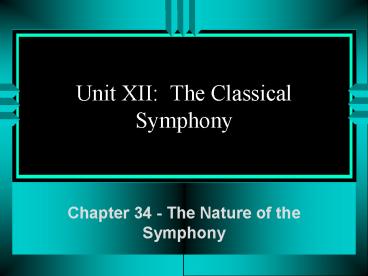Unit XII: The Classical Symphony PowerPoint PPT Presentation
1 / 14
Title: Unit XII: The Classical Symphony
1
Unit XII The Classical Symphony
- Chapter 34 - The Nature of the Symphony
2
Historical Background
- Occupied the central place in instrumental music
of the Classical Era. It grew in significance
until, with the final works of Mozart and Haydn,
it became the most important type of absolute
music.
3
Historical Background
- Finds its roots in the Italian opera overture.
- three sections
- fast-slow-fast
- The three sections of the overture eventually
expand to become separate movements.
4
Historical Background
- Additions by German symphonists
- Rocket - addition through Mannheim School
- Mozart, Symphony No. 40 in g, IV (MEB III/3)
- Drawn-out crescendos
- Mozart, Sinfonia Concertante for Violin and Viola
in E flat, I (MEB III/4)
5
Historical Background
- Addition of the minuet and trio (also a Mannheim
contribution), making the 4-movement sonata cycle
the norm for the symphony as it was in the string
quartet.
6
The Classical Orchestra
- Established modern orchestra
- String dominated
- Woodwinds were solo instruments and provided
color - Brass sustained harmonies and added to the tone
mass. - Kettle drums (tympani) are primary percussion.
7
The Classical Orchestra
- 30-40 players, still a salon ensemble, quieter
than modern orchestra. - Thematic treatment tended to be democratic,
conversational.
8
The Classical Orchestra
- The orchestra brought inventions of crescendo and
decrescendo to the fore. Also stressed abrupt
dynamic changes, sudden accents, dramatic pauses,
and the use of tremolo and pizzicato.
9
The Movements of the Symphony
10
First movement - Sonata-allegro form
- Based on the opposition of two keys personified
by the contrast between two themes. - Mozart, Symphony No. 40 in g, I
- Especially in later Haydn, he preferred to use a
single theme for both key areas. These
symphonies are said to utilize a monothematic
sonata form. - Haydn, Symphony No. 45 in f sharp
11
Second movement
- Slow tempo
- Contrasting key
- Forms
- A-B-A
- theme and variations
- Sonatina (a modified sonata-allegro form without
a development section)
12
Second movement
- Colorful orchestration, emphasizing the
woodwinds - Mood more lyrical than the first movement,
therefore, themes are less developmental in nature
13
Third movement
- Minuet and Trio in a graceful triple meter.
- Replaced by the scherzo in Beethoven's symphonies.
14
Fourth movement
- Usually faster and lighter than the first
movement - Rondo or sonata-allegro form
- Often a folk-dance character in Haydn
- Beginning with the finale to Beethoven's Fifth
Symphony, this is a triumphal sonata-allegro.

